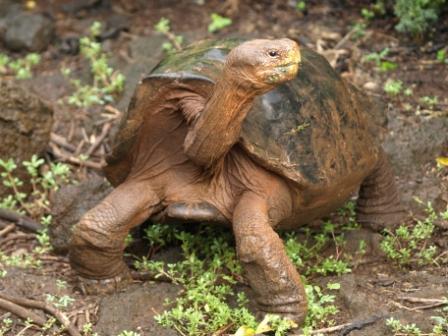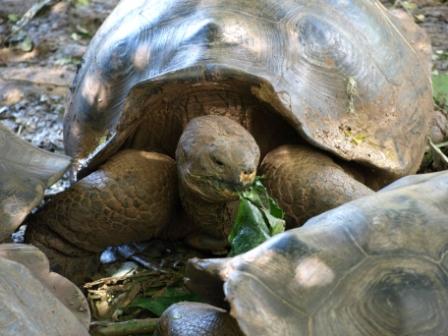Not even my mother thinks I'm beautiful

VulcanSpirit
Richard & Alison Brunstrom
Mon 30 Apr 2012 17:11
|
In UK English tortoises live on land, turtles live
in the sea and terrapins live in fresh water. US and Australian usages are
different and confusing, so I'm sticking to UK terminology. The evolutionary
history of this group of reptiles is really interesting - they just can't make
their minds up where they want to live. The turtle/tortoise shell body form
evolved on land - turtles have secondarily returned to the sea but still lay
their eggs on land (interestingly, male turtles cannot leave the water ever
again after entering the sea as hatchlings - their front flippers are now
not strong enough to propel themselves on land). But modern research shows that
the current tortoises have evolved from sea turtles, and not from the earlier
land version as you might have expected. And modern terrapins have evolved from
these 'second generation' land tortoises. Why this should be happening
nobody knows, but it's certainly odd.
Anyway, tortoises arrived in Galapagos about 2
million years ago from South America. They are very closely related to a
tortoise still living there, Geochelone chilensis. Tortoises float in seawater with their heads above the surface
and amazingly are known to be able to survive without food or freshwater for at
least six months and possibly two years which is why they make such good
colonisers of oceanic islands.
The tortoises arrived once only, and spread
throughout the islands. Each population became genetically isolated and a large
number of separate species evolved. There are at least 14 species, three of
which are recently extinct (due to their use by whalers as a source of food).The
exact number is still in scientific dispute - recently it has been decided that
the Santa Cruz tortoise is in fact three separate species living
in different parts of the island.
The island of Isabela houses five separate species
of giant tortoise, one for each of its five volcanoes (the upper reaches of
which, at up to 1500m, provide particularly suitable habitat with more water).
It's a hazardous and precarious existence though. These volcanoes are still
active, and genetics shows that one species was fairly recently reduced to a
single pregnant female (or more likely a single clutch of eggs) as a result of
an eruption.
Darwin didn't recognise the relevance of the
tortoises. He didn't visit all the islands and never picked up on the amazing
variation of tortoise types which have clearly originated from one founding
species - exactly what he did realise with the Galapagos birds.
There are three basic tortoise types. All are
'giants', having undergone island gigantism which is a well recognised adaption
to island life worldwide for reasons that are not yet clear. Confusingly island
dwarfism (as seen in Galapagos with the flightless cormorant, penguin and
the sealions is equally common; there used to be a pygmy hippo on Crete). One
type has the 'normal' tortoise shell shape and lives at higher elevations in
wetter habitats where it can graze grasses at ground level - all the Isabela
tortoises are of this form. The second type has a saddle shape to the front of
the shell (hence Galapagos - galapaga is a Spanish name for this sort of high
crowned saddle, transferred to the tortoises). This saddle back enables them to
browse vegetation further from the ground as found in the more arid environments
at lower elevation - exactly the same evolutionary route that giraffes have
followed. The third type is 'intermediate' between the first two.
Here is a female saddleback tortoise, about a metre
long. The males are much larger:
 This is Geochelone hoodensis from Espanola
(originally Hood - all the islands were previously named after British
warships). You can clearly see the saddleback and the ability it affords to
graze vegetation further from the ground. Of course this adaptation renders the
shell just about useless as protection from attack - it could only evolve in a
place like Galapagos where there are no predators of
tortoises.
And here is an 'intermediate' type from San
Cristobal:
 This is G. chatamensis from San Cristobal
(Chatam). Note the growth rings on the shell which denote age just like a tree.
These are young adults in a breeding centre. Tortoises become sexually mature at
about 30-40 years, and can live a long time - certainly well in excess of 150
years, but nobody really knows how long, yet!
|